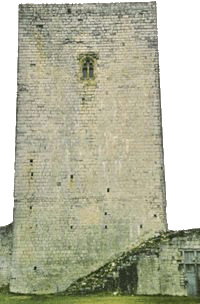Entering in at the Ninth Gate...
Aug 28, 2013 5:53:01 GMT
Post by Goldenfleeced on Aug 28, 2013 5:53:01 GMT
The Château de Puivert is a Cathar castle situated in the commune of Puivert, in the Aude département of the Languedoc. This building, on top a hill overlooking the village and its lake, reaches an altitude of 605 m.
In the twelfth century a castle stood on this site, which had strong Cathar and troubadour links. A meeting of troubadours took place here in 1170, and in 1185 festivities attended by the Viscount of Carcassonne and Loba, Lady of Lastours (Cabaret).
At the start of the Wars against the Cathars, the so-called Albigensian Crusade, Puivert's seigneur was Bernard de Congost. His wife Alpaïs had become a Parfaite before her death just a year earlier in 1208.
In November 1210 the Castle was besieged (just after the fall of Termes) by Simon de Montfort, and fell after three days. The dispossessed Congost family carried on the fight against the invaders.
Bernard died after receiving the Cathar Consolamentum at Montségur in 1232. His son fought on, participating in the events of Avignonet in 1242 and helping defend the Château of Montségur in 1243-4.
In 1213 the seigneurie, now in French hands, was conferred by Simon de Montfort on one of his lieutenants, Lambert de Thury. Later it was allocated to Pons de Bruyère.
At the start of the 14th century, probably around 1310, Thomas de Bruyère, grandson of Pons, built the present castle, to the east of the old "Cathar castle". His wife was Isabelle de Melun, daughter of a Grand Chamberlain of France, whose arms are still to be seen in the building.
One room has fine carvings of minstrels, and tourists are often told that troubadours played in this room. This is absolute rubbish, but if you look behind the castle you will find the foundations of the earlier castle where troubadours really did play.
The castle, 600 meters (1970 feet) above sea level, is sited on a green hill top (Puig-Vert). Perhaps the significance of the name is that most castles in the area are not on green hill tops, but rocky mountain tops.
Some points of note are:
- The tower gate on the east side of the courtyard. You can see the de Bruyère arms (a lion rampant with a forked and knotted tail) carved in stone above the doorway. The bridge over the ditch would have been a drawbridge. You can still see the portcullis, and the two holes where beams would have projected to hoist the bridge.
- The courtyard is 80 meters long and 40 wide (260 x 130 feet), surrounded by a curtain wall and the remains of six towers. In the Northwest corner is a postern gate (used for surprise sorties against besiegers) called the Chalabre Gate
- The donjon (keep) is 35 meters (115 feet) tall and 15 meters (49 feet) across each side. On the west of the keep are traces of an adjoining building. Each of the four stories contains a single room, with a defensive platform at the fifth level. The keep comprises:
- Two lower levels with barrel vaulting
- The third floor is the chapel. It is decorated with columns, moldings and shields. The ceiling is rib-vaulted. Note the keystone of the arch. In the wall is a piscina. It is not that usual to find chapels like this with rooms above them.
- The fourth floor is a rib vaulted room, the culs-de-lampe sculpted with figures playing musical instruments. The Window seat is about 3 meters (20 feet) long.This is the so-called Minstrels' Chamber ("Salle des Musiciens"). The 8 musicians each play a different medieval instrument: bagpipes, hurdy-gurdy, tambourine, lute, portable organ, psaltery, rebeck and cithern. The room is relatively well-lit - castle rooms typically have larger windows further up the walls. Note the thickness of the walls, and the bench seats by the windows, the only part of the room that was really well let, where ladies would sew.
- The fifth and top floor is a defensive platform and watch tower(guet), originally crenelated.
Well, well... Cathars... Cathari... Cats... lol...
A strange place, indeed, to find 'Luciferians,' I would think... or not. There must be a reason... there always is.
But, in the meantime... we have a 'hurdy gurdy man.' Until later tonight, then... I'll be back to try and wrap this one up... more or less...
I could only come up with the one minstrel... but it's a really good show...
Enjoy...
Read more: innerchamber.proboards.com/thread/644/entering-ninth-gate?page=2#ixzz2dEvCvr5B
In the twelfth century a castle stood on this site, which had strong Cathar and troubadour links. A meeting of troubadours took place here in 1170, and in 1185 festivities attended by the Viscount of Carcassonne and Loba, Lady of Lastours (Cabaret).
At the start of the Wars against the Cathars, the so-called Albigensian Crusade, Puivert's seigneur was Bernard de Congost. His wife Alpaïs had become a Parfaite before her death just a year earlier in 1208.
In November 1210 the Castle was besieged (just after the fall of Termes) by Simon de Montfort, and fell after three days. The dispossessed Congost family carried on the fight against the invaders.
Bernard died after receiving the Cathar Consolamentum at Montségur in 1232. His son fought on, participating in the events of Avignonet in 1242 and helping defend the Château of Montségur in 1243-4.
In 1213 the seigneurie, now in French hands, was conferred by Simon de Montfort on one of his lieutenants, Lambert de Thury. Later it was allocated to Pons de Bruyère.
At the start of the 14th century, probably around 1310, Thomas de Bruyère, grandson of Pons, built the present castle, to the east of the old "Cathar castle". His wife was Isabelle de Melun, daughter of a Grand Chamberlain of France, whose arms are still to be seen in the building.
One room has fine carvings of minstrels, and tourists are often told that troubadours played in this room. This is absolute rubbish, but if you look behind the castle you will find the foundations of the earlier castle where troubadours really did play.
The castle, 600 meters (1970 feet) above sea level, is sited on a green hill top (Puig-Vert). Perhaps the significance of the name is that most castles in the area are not on green hill tops, but rocky mountain tops.
Some points of note are:
- The tower gate on the east side of the courtyard. You can see the de Bruyère arms (a lion rampant with a forked and knotted tail) carved in stone above the doorway. The bridge over the ditch would have been a drawbridge. You can still see the portcullis, and the two holes where beams would have projected to hoist the bridge.
- The courtyard is 80 meters long and 40 wide (260 x 130 feet), surrounded by a curtain wall and the remains of six towers. In the Northwest corner is a postern gate (used for surprise sorties against besiegers) called the Chalabre Gate
- The donjon (keep) is 35 meters (115 feet) tall and 15 meters (49 feet) across each side. On the west of the keep are traces of an adjoining building. Each of the four stories contains a single room, with a defensive platform at the fifth level. The keep comprises:
- Two lower levels with barrel vaulting
- The third floor is the chapel. It is decorated with columns, moldings and shields. The ceiling is rib-vaulted. Note the keystone of the arch. In the wall is a piscina. It is not that usual to find chapels like this with rooms above them.
- The fourth floor is a rib vaulted room, the culs-de-lampe sculpted with figures playing musical instruments. The Window seat is about 3 meters (20 feet) long.This is the so-called Minstrels' Chamber ("Salle des Musiciens"). The 8 musicians each play a different medieval instrument: bagpipes, hurdy-gurdy, tambourine, lute, portable organ, psaltery, rebeck and cithern. The room is relatively well-lit - castle rooms typically have larger windows further up the walls. Note the thickness of the walls, and the bench seats by the windows, the only part of the room that was really well let, where ladies would sew.
- The fifth and top floor is a defensive platform and watch tower(guet), originally crenelated.
Well, well... Cathars... Cathari... Cats... lol...
A strange place, indeed, to find 'Luciferians,' I would think... or not. There must be a reason... there always is.

But, in the meantime... we have a 'hurdy gurdy man.' Until later tonight, then... I'll be back to try and wrap this one up... more or less...
I could only come up with the one minstrel... but it's a really good show...
Enjoy...

Read more: innerchamber.proboards.com/thread/644/entering-ninth-gate?page=2#ixzz2dEvCvr5B





